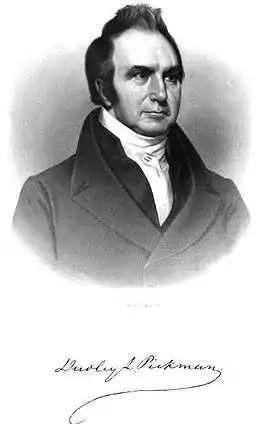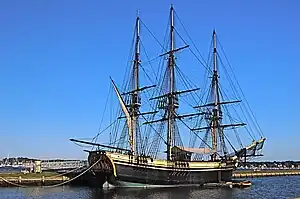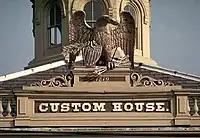
Dudley Leavitt Pickman (1779–1846) was an American merchant who built one of the great trading firms in Salem, Massachusetts, during the seaport's ascendancy as a trading power in the late eighteenth and early nineteenth centuries.[1] Pickman was a partner in the firm Devereux, Pickman & Silsbee and a state senator. Among the wealthiest Salem merchants of his day, Pickman used his own clipper ships to trade with the Far East in an array of goods ranging from indigo and coffee to pepper and spices,[2] and was one of the state's earliest financiers, backing everything from cotton and woolen mills to railroads to water-generated power plants. Pickman also helped found what is today's Peabody Essex Museum.
Early life and career
Dudley Leavitt Pickman was born at Salem, Massachusetts, in May 1779, the second son of Salem's chief Naval Officer, William Pickman (1748–1815) and his wife Elizabeth (Leavitt) Pickman, daughter of Dudley Leavitt,[3] an early Congregational minister in Salem, and his wife Mary (Pickering) Leavitt, sister of United States Secretary of State Timothy Pickering. William Pickman secured his son [4] a position in 1799 as a clerk for Chief Customs Collector Major Joseph Hiller.[5] After working briefly for Hiller, Dudley Leavitt Pickman left the Customs Service in 1799 to go to sea as a ship's supercargo – business agent for the owner.[6]
Pickman embarked on a merchant's career as a young man. He helped found the East India Marine Society (today's Peabody Essex Museum) of Salem in November 1800. (Joining two months prior was the eminent Salem merchant Elias Hasket Derby as well as Nathaniel Bowditch).[7] In 1804 the East-India Marine Society moved to the Pickman Building on Essex Street, which had been specially fitted for the society.[8]
Early in his career, Pickman traveled to India as supercargo on a ship belonging to several Salem merchants. In his diary of the journey, Journal of the Belisarius, Pickman noted the appearance of the British fort at Calcutta: "Fort St. George is a handsome brick fortification. It appears very strong, but is probably too much extended to make as able a defense as might otherwise be done."[9]
Pickman kept journals on several of his other voyages as supercargo and then owner, and as its charter required, these journals were filed with the East-India Marine Society of Salem. These early documents show the vast reach of the large Salem trading houses. In 1799–1800, for instance, Pickman noted that the Belisarius had traveled first to the island of Tenerife, back to Salem, then on to Madras and Tranquebar, India, before returning to the Massachusetts port loaded with her bounty.[10] The following year, Pickman kept the journal of the voyage of the ship Anna, captained by Benjamin Swett, which sailed from Boston to Sumatra and back in 1801.[7]
Pickman made his early career out of repeated trips on the Belisarius. Before the ship went to pieces in a gale in the Bay of Tunis in April 1810, the 94-foot (29 m) clipper made repeated voyages to India and Sumatra with several captains in command and Pickman acting as supercargo. The clipper ship's voyages prompted Salem cleric Dr. William Bentley to call her "one of the richest ships of our port".[11] (Captain Samuel Skerry, the most renowned of the Belisarius's captains, died at age 36 after being kicked in the stomach by a horse.)
Later career
Pickman soon founded his own trading firm. He and his partners owned an array of clipper ships including the brig Endeavor, the Malay, the Borneo,[12] the Belisarius, the Herald,[11] the Coromandel, the Persia, the Friendship and others.[2] The ships traded with India, Zanzibar, Madagascar, Sumatra, Java, the Philippines, Malaya and other far-flung trading ports.

Initially a partner of the Salem trading firm of Stone, Silsbees, Pickman & Allen, Pickman later became one of two partners of the firm of Silsbee & Pickman, one of the largest Salem trading houses, operated by Nathaniel Silsbee and Pickman.[13] Pickman made much of his early fortune from trade with India. He later helped finance some Indian factories as an owner.[14] His firm was so influential that was known in Salem as "The Old East-India Company".[15]
As Pickman's business investments took off, he became an active financier, and owned interests in emerging industries across New England. He was a founding investor in the companies that developed the water power and owned much of the real estate in Lowell, Manchester and Lawrence. He was also a large stockholder in many cotton and woolen mills in Massachusetts and New Hampshire, and was a large investor in many early railroad companies.[16] In 1818, Pickman purchased 50 shares of the Suffolk Bank, a clearinghouse bank on State Street in Boston.[17]
Pickman was an active merchant, writing to politicians such as Henry Clay to promote his mercantile interests and arguing for the need for protective tariffs.[18] Pickman also frequently corresponded with other powerful merchants and statesmen such as Paine Wingate[19] and Samuel Curwen.[20]
Pickman was heavily involved in nearly all aspects of Salem's municipal and business life. He served with Leverett Saltonstall and Nathaniel Bowditch as trustees of the estate of Simon Forrester. A ship captain born in Ireland, Forrester had become one of the pioneers of Salem merchant shipping and became one of Salem's leading merchants and philanthropists.
The large brick mansion built for Pickman by architect Jabez Smith in 1819 at the corner of Chestnut and Pickering Streets in Salem was later known as the Shreve-Little House (and later still as the Baldwin-Lyman House).[21][22] Pickman married on September 6, 1810, Catherine Saunders, daughter of Salem merchant Thomas Saunders[23] and his wife Elizabeth (Elkins) Saunders.[24]
Dudley Leavitt Pickman was a longtime member of Salem's old North Church. His portrait is owned by the Peabody Essex Museum, where it forms part of a collection of the founders of Salem's East India Marine Society in 1799. In the Massachusetts Historical Society is a copy of William Shakespeare's Twelfth Night from the library of Dudley Pickman Leavitt – a copy of the first publication in America of the English playwright's work.[25]

Descendants and legacy
Dudley Leavitt Pickman's son William Dudley Pickman continued the family trading enterprises, eventually moving the shipping interests to Boston but retaining a counting house in Salem.[26] William Dudley Pickman married Caroline Silsbee, daughter of Salem merchant Zachariah F. Silsbee. William Dudley Pickman's partner in the Boston-based firm was his son Dudley Leavitt Pickman,[27] who became a fixture in Boston business and social circles, and a large donor of family art and antiques to the Boston Museum of Fine Arts,[28] as well as a trustee of Salem's Peabody Museum.[29]
Dudley Leavitt Pickman's daughter Elizabeth became the second wife of Salem merchant Richard Saltonstall Rogers, whose first wife Sarah Crowninshield died young.[30] Pickman's daughter Catherine Saunders married Boston merchant Richard S. Fay.[16] One of Pickman's sons, Edward Motley, attended Harvard Law School, and became a Boston writer.[31]
His son Dudley Leavitt Pickman Jr. attended Noble and Greenough School,[32] Harvard College, where he was president of the Hasty Pudding Club,[33] and Harvard Law School,[34] practiced law in Boston and lived in a 40-room granite mansion, staffed by five servants and designed by architect Stanford White at 303 Commonwealth Avenue in Boston, as well as in Beverly, Massachusetts.[35] He served as a director for a number of public companies, including a subsidiary of Calumet and Hecla Mining Company[36] and as one of the first three trustees of the Henry Wadsworth Longfellow House National Park site in Cambridge, Massachusetts.[37]
Dudley Leavitt Pickman Jr. continued the family's tradition of making gifts of significant family heirlooms and antiques to the collection of the Boston Museum of Fine Arts,[38] including a teapot by silversmith John Coburn bearing the Pickman family coat of arms.[39] Born in Geneva, Switzerland, in 1885, Dudley Leavitt Pickman Jr. also became a noted mountaineer and porcelain expert,[40] who published several books on the subject.[41] Along with his friends Harold Stirling Vanderbilt, Francis Bacon and Frederic Allen, Pickman played the first game of contract bridge in its modern form.[42] He married the widow of Boston businessman Alexander Lynde Cochrane.[35]
In its obituary of Dudley Leavitt Pickman Jr., The New York Times noted the lawyer and author's service as trustee of the Boston Museum of Fine Arts,[43] as well as his avocation as "a noted mountain climber". Pickman, who died at his residence at 38 Beacon Street on Beacon Hill, was 87.[44]

The Pickman family intermarried with other prominent early Salem and Boston families, including that of Joseph Story Fay,[45] the Crowninshields, the Pickerings, the Rodmans, the Silsbees, Rogers,[46] Saunders and Motleys and others.[47]
The family also later owned an estate located near Two Brothers Rocks in Bedford, Massachusetts, so named because the lands were patented by both Massachusetts Bay Colony governors John Winthrop and Thomas Dudley.[48] Dudley Leavitt Pickman and his progeny were descended from both early governors.[49][50]
The Salem merchant Dudley Leavitt Pickman is buried at Salem's Harmony Grove Cemetery, not far from the grave of his partner, merchant and United States Senator from Massachusetts Nathaniel Silsbee. Pickman's tombstone reads: "A successful merchant, distinguished for his sound practical good sense and an inflexible regard to truth and justice."[51]
See also
References
- ↑ Pickman's career coincided with Salem's rise as a trading powerhouse. By the time Pickman's son took over the family interests, many of the town's early trading firms had moved on to Boston, with subsidiary offices in Salem.
- 1 2 Essex Institute Historical Collections, Vol. LVII, Essex Institute, Peabody Essex Museum, Printed for the Essex Institute, Salem, Mass., 1921
- ↑ Salem's Leavitt Street is named for the early Congregational minister.
- ↑ The eldest son of William and Elizabeth Pickman was William Pickman Jr., who was lost at sea on December 13, 1798.
- ↑ Old Time Ships of Salem, Robert Samuel Rantoul, William O. Chapman, Essex Institute, Salem, Mass., 1917
- ↑ Pickled Fish and Salted Provisions, Historical Musings from Salem Maritime National Historic Site, National Park Service
- 1 2 The East-India Marine Society of Salem, Printed by W. Palfray Jr., Boston, Mass., 1821
- ↑ The Marine Room of the Peabody Museum of Salem
- ↑ Book Extract, The Yankees Have Landed, indiaprofile.com
- ↑ Pickman made several trips to India, and kept detailed journals of his visits.
- 1 2 Salem Vessels and Their Voyages: A History of the Pepper Trade with the Island of Sumatra, George Granville Putnam, The Essex Institute, Salem, Mass., 1922
- ↑ Ship Registers of the District of Salem and Beverly, Massachusetts, 1789–1900, Frank Hitchings, Stephen Willard Phillips, The Essex Institute, Salem, Mass., 1906
- ↑ Dudley Leavitt Pickman was a member of several trading firms with his name in the title, as was his son William Pickman. Other family members were also owners of other Salem shipping and trading firms, so there are a number of such firms with Pickman in the title: Silsbee, Pickman & Allen; Stone, Silsbee & Pickman; Stone, Silsbees, Pickman & Allen; and others.
- ↑ Americans in Calcutta Bazaars in the Early Nineteenth Century, Sirajul Islam, The Asiatic Society Archived July 6, 2011, at the Wayback Machine
- ↑ The Rich Men of Massachusetts, Abner Forbes, Published by W. V. Spencer, Boston, Mass., 1851
- 1 2 History of Essex County, Massachusetts, Vol. I, D. Hamilton Hurd, J. W. Lewis & Co., Philadelphia, Penn., 1888
- ↑ Whitney, David R. (1878), The Suffolk Bank, Cambridge, MA: Riverside Press, pp. 4–5
- ↑ Papers of Henry Clay, Secretary of State, 1825, Vol. 4, James F. Hopkins, The University Press of Kentucky, 1972 ISBN 978-0-8131-0054-8
- ↑ "Paine Wingate Papers, Houghton Library, Harvard University". Archived from the original on 2012-03-09. Retrieved 2008-12-23.
- ↑ The Journal and Letters of Samuel Curwen, Samuel Curwen, George Atkinson Ward, Little, Brown & Co., Boston, Mass., 1864
- ↑ The Colonial Architecture of Salem, Frank Cousins, Phil M. Riley, Little, Brown and Co., Boston, 1919
- ↑ Domestic Architecture of the American Colonies and of the Early Republic, Fiske Kimball, Metropolitan Museum of Art, Charles Scribner's Sons, New York, 1922
- ↑ The Saunders family were longtime Salem merchants who built some of the town's earliest warehouses and ships. The surname was sometimes spelled Sanders.
- ↑ A Salem Shipmaster and Merchant, The Autobiography of George Nichols, The Four Seas Company, Boston, Mass., 1921
- ↑ Shakespeariana, Charlotte Endymion Porter, Shakespeare Society of New York, Vol. X, Leonard Scott Publication Co., New York, 1893
- ↑ William Dudley Pickman, Obituary, Essex Institute Historical Collections, Essex Institute, Peabody Essex Museum, Vol. XXVII, Printed for the Essex Institute, Salem, 1890
- ↑ Pickman's bookplate placed in the volumes of his library had this inscription: "The wicked borrow and return not."
- ↑ Meissen Teapot, Gift of Dudley Leavitt Pickman, Boston Museum of Fine Arts
- ↑ Guide to the Peabody Museum, Peabody Museum of Salem, Salem, Massachusetts, 1916
- ↑ Eliza Leavitt Pickman, Phillips, Howard, Fay Genealogy, Eighth Generation
- ↑ Secretary's Third Report, Harvard College Class of 1908, Decennial Report 1920, Cambridge, Massachusetts, 1920
- ↑ Secretary's Fourth Report, Harvard College Class of 1907, June 1917, The Plimpton Press, Norwood, Massachusetts, 1917
- ↑ Catalogue of the Members and Library of the Hasty Pudding Club in Harvard, The Marion Press, New York, 1902
- ↑ Harvard Law Review, Vol. XXIII, 1909–1910, The Harvard Law Review Association, Cambridge, Massachusetts, 1910
- 1 2 "Society: Open End". Time. July 20, 1962.
- ↑ The Manual of Statistics, Lee Higginson & Co., New York
- ↑ Longfellow House Trust, Records, 1852–1973, National Park Service
- ↑ Bulletin of the Museum of Fine Arts, Number 166, Boston, April 1930 Archived July 16, 2011, at the Wayback Machine
- ↑ Art in a Season of Revolution: Painters, Artisans, and Patrons in Early America, Margaretta M. Lovell, Published by University of Pennsylvania Press, 2007, ISBN 978-0-8122-1991-3
- ↑ Dudley Leavitt Pickman's books ran the gamut from his 1933 work on mountaineering, Some Mountain Views, a reflection on Pickman's climbs on the Matterhorn and other peaks , and his 1955 The Picture of Everest, to his 1936 work on porcelain The Golden Age of European Porcelain, and his 1938 treatise on the same subject, published in conjunction with the Boston Museum of Fine Arts, entitled Pouring Vessel Vagaries.
- ↑ Dudley Leavitt Pickman Jr. became a noted expert in the field of European porcelain. Most of his collection he donated to the Boston Museum of Fine Arts.
- ↑ The New York Times Bridge Book: An Anecdotal History of the Development, Personalities, and Strategies of the World's Most Popular Card Game, Alan Truscott, Published by Macmillan, 2004, ISBN 9780312331078
- ↑ Museum of Fine Arts Bulletin, Vol. XIX, 1921, Museum of Fine Arts, Boston, Mass.
- ↑ "Dudley L. Pickman; Boston Museum Trustee, Member of Old New England Family", The New York Times, Obituary, June 10, 1938
- ↑ "A. S Webb Marries Mrs. W. H. Russell". The New York Times, May 11, 1916.
- ↑ Eleventh Report of the Class of 1869 of Harvard College, June, 1919, Fiftieth Anniversary, The Riverside Press, Cambridge, Massachusetts, 1919
- ↑ Genealogy of the Rodman Family, 1620 to 1886, Charles Henry Jones, Printed by Allen, Lane & Scott, Philadelphia, 1886
- ↑ History of the Town of Bedford, Middlesex County, Massachusetts, from Its Earliest Founding to the Year of Our Lord 1891, Abram English Brown, Published by the Author, Bedford, Mass., 1891
- ↑ Old Paths and Legends: Saunterings Over Historic Roads, with Glimpses of Picturesque Fields and Old Homesteads in Massachusetts, Rhode Island, and New Hampshire, Katharine Mixer Abbott, Published by G. P. Putnam's sons, 1908
- ↑ Dudley Leavitt Pickman's grandfather Rev. Dudley Leavitt of Salem was the son of Moses Leavitt of Stratham, New Hampshire and his wife Sarah Ann (Leavitt) Leavitt, the daughter of Samuel Leavitt and so first cousin to her husband.
- ↑ Harmony Grove Cemetery, Salem, Mass, Published by G. M. Whipple and A. A. Smith, Salem, Mass., 1866
External links
- Dudley Leavitt Pickman Papers, Phillips Library, Peabody Essex Museum, Salem, Massachusetts
- Portrait of Dudley Leavitt Pickman, Peabody Essex Museum, Salem, Massachusetts
- Portrait of Dudley Leavitt Pickman, History of Essex County, Massachusetts, Duane Hamilton Hurd
- Grave of Elizabeth Leavitt Pickman, mother of Dudley Leavitt Pickman, Broad Street Cemetery, Salem, Massachusetts, gravematter.smugmug.com
Further reading
- Yankee India: American Commercial and Cultural Encounters with India in the Age of Sail, 1784-1860, Susan S. Bean, Peabody Essex Museum, 2001, ISBN 978-81-85822-83-9
- Pickled Fish and Salted Provisions, Historical Musings from Salem Maritime National Historic Site, National Park Service